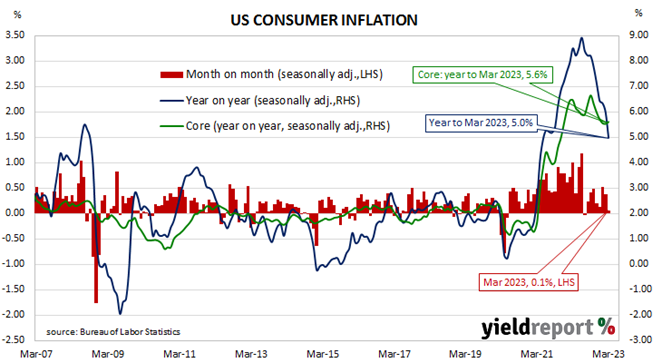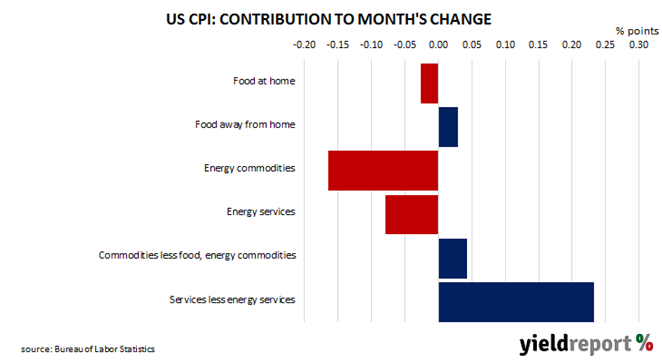Summary: US CPI up 0.1% in March, less than expected; “core” rate up 0.4%; “good news” in headline CPI but core inflation remains “elevated”; Treasury yields generally fall; rate-cut expectations firm; main downside surprise from easing in shelter prices; non-energy services prices main driver, adds 0.23 ppts.
The annual rate of US inflation as measured by changes in the consumer price index (CPI) halved from nearly 3% in the period from July 2018 to February 2019. It then fluctuated in a range from 1.5% to 2.0% through 2019 before rising above 2.0% in the final months of that year. Substantially lower rates were reported from March 2020 to May 2020 and they remained below 2% until March 2021. Rates have since risen significantly although they have been declining in recent months.
The latest US CPI figures released by the Bureau of Labor Statistics indicated seasonally-adjusted consumer prices increased by just 0.1% on average in March. The result was noticeably lower than 0.4% increase which had been generally expected as well as February’s 0.4% rise. On a 12-month basis, the inflation rate slowed from 6.0% to 5.0%.
“Headline” inflation is known to be volatile and so references are often made to “core” inflation for analytical purposes. The core prices index, the index which excludes the more variable food and energy components, increased by 0.4% on a seasonally-adjusted basis for the month. The rise was in line with expectations but less than February’s 0.5% increase. However, the annual growth rate ticked up from 5.5% to 5.6%.
“Overall the US CPI report was mixed. While there was good news in the headline print with an easing in food price inflation, core inflation remains elevated; the ‘supercore’ services component of CPI …remains high at 6.4% YoY,” said NAB Head of Markets Strategy Skye Masters.
US Treasury bond yields mostly fell on the day. By the close of business, the 2-year Treasury yield had shed 5bps to 3.97%, the 10-year yield had lost 3bps to 3.40% while the 30-year yield finished 1bp higher at 3.63%.
In terms of US Fed policy, expectations of a higher federal funds rate over the next few months softened while expectations of rate cuts further out hardened. At the close of business, contracts implied the effective federal funds rate would average 4.83% in April, in line with the current spot rate, and then climb to an average of 4.99% in May. June futures contracts implied a 5.015% average effective federal funds rate while April 2024 contracts implied 3.915%.
“The main downside surprise to March’s CPI was the long-awaited easing in shelter prices finally starting to materialise,” said Citi economist Veronica Clark. “While slowing shelter prices increase the uncertainty around upcoming monthly CPI prints, our forecast for consistent strength in non-shelter core services and renewed increases in components like used cars lead us to continue to expect 0.4-0.6% increases in core CPI in April and May.”
The largest influence on headline results is often the change in fuel prices. Prices of “Energy commodities”, the segment which contains vehicle fuels, decreased by 4.6% and subtracted 0.16 percentage points from the total. However, prices of non-energy services, the segment which includes actual and implied rents, again had the largest effect on the total, adding 0.23 percentage points after increasing by 0.4% on average.



